Gebali F. Analysis Of Computer And Communication Networks
Подождите немного. Документ загружается.

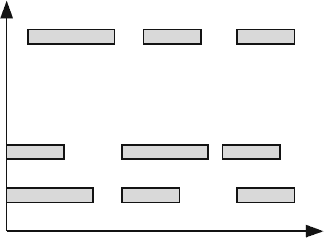
13.4 Circuit and Packet Switching 481
Fig. 13.3 Frequency division
multiple access assigns a
frequency band to each user.
The gaps between packets
indicate that the channel is
idle and the frequency band is
not in use
Frequency
Band
N
...
2
1
Time
Similar to TDMA, there are two ways that SDMA could be used. Fixed as-
signment is called circuit switching and is discussed in Section 13.4.1. Random
assignment is called packet switching which is discussed in Section 13.4.2.
13.3.3 Frequency Division Multiple Access (FDMA)
In this technique, each user is assigned a unique frequency band in the frequency
spectrum. Radio and analog TV broadcasting use this technique where each station
is allocated a frequency band. Figure 13.3 shows the assignment of the frequency
bands among users versus time.
This technique is also used in optical fibers by assigning a particular optical
wavelength (light color) to each channel. This is known as wavelength division
multiple access (WDMA).
13.3.4 Code Division Multiple Access (CDMA)
In code division multiple access technique, data from each user are used to modulate
a unique binary pattern that belongs to the user. The binary patterns (called polyno-
mials) are designed such that no interference takes place when the signals are sent.
At the receiver end, information carried on each pattern can be extracted with no
interference from the other signals. Figure 13.4 shows an example of CDMA where
N codes are used to transmit data from N users.
13.4 Circuit and Packet Switching
In digital communications, there are two main techniques for establishing a path
through the network: circuit switching and packet switching.
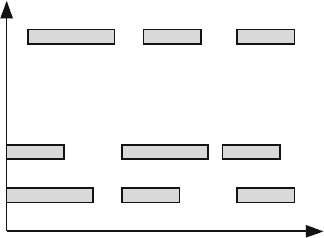
482 13 Switches and Routers
Fig. 13.4 Code division
multiple access assigns a
binary pattern (or
polynomial) to each user. The
gaps between packets
indicate that the channel is
idle and the channel is not in
use
Binary Code
(Polynomial)
N
...
2
1
Time
13.4.1 Circuit Switching
In circuit switching, a unique path is used to move data between the two end users.
Thus, the path or the resource is reserved for the duration of a particular session. This
is a waste of resources when there is no activity on the channel while other users
are waiting to access the channel. Constant bit rate traffic does well with circuit
switching since the path is dedicated and there are always data sent on the channel.
Computer communication, however, is bursty and does not do well under circuit-
switched techniques. The telephone network is circuit switched and the path is held
up by the user until it is released.
The important characteristics of circuit switching are as follows:
1. Overhead of establishing the path is only spent at the start of the session.
2. Data format is simple since the path is already established beforehand.
3. In-sequence delivery of data is possible since all packets will arrive using the
same route.
4. The channel bandwidth is guaranteed and this suites constant bit rate traffic.
5. The channel is better utilized carrying constant bit rate traffic and not bursty
traffic.
6. Traffic information is easily observable since switching nodes maintain informa-
tion about each call.
To establish a path in circuit switching, three consecutive phases are required:
1. Connection establishment: For data to be transferred between two end users,
a connection (path) must be established. The intermediate switches exchange
information related to the availability of a path and inform the end users when
the path is available. This is similar to using the phone by waiting for the dial
tone, then dialing the desired number.
2. Data transfer: Data can now be moved between the users over the connection
that was established. The type of connection will determine the data rate, average
delay, and data loss rate. This is similar to talking on the phone once the other
party picks up the phone.
13.4 Circuit and Packet Switching 483
3. Connection tear down: After data transfer is complete, the end users inform the
intermediate switches to free the connection. This is similar to placing the phone
on the hook to inform the phone company that the circuit can be released.
13.4.2 Packet Switching
In packet switching, data are broken into packets of fixed or variable size, depending
on the protocol used. There are two approaches for packet switching: datagram and
virtual circuit.
In datagram switching, each packet carries with it all the routing information it
needs to reach its destination and each packet is treated independently of the ones
before it or after it. In fact, it is possible that different packets might travel down
different paths. This is actually an advantage since the resulting network is immune
to faults, and packets can be dynamically routed on any available links. This was the
main reason for using packet communication in the first place in the 1970s to build a
highly fault-tolerant communication network that is immune to enemy attack. Since
each packet carries all the information it needs to determine its destination, there
is no need to establish a connection before transmitting the data. The connection
establishment phase of circuit switching is removed. However, packet switching
carries the following penalties:
1. In-sequence delivery of data is not possible since different packets might travel
down different paths.
2. Packet routing will be complex since the router has to choose the optimum route
to send each packet.
3. Packet delay will vary depending on the route chosen for each packet.
4. Packet loss cannot be detected by the network. The end-nodes are able to detect
lost packets.
5. Traffic information is not easily observable since switching nodes do not have
information about the state of each stream.
In virtual circuit switching, a unique path is used to move data between the two
end users. This is similar to the circuit switching approach. However, the channel or
path could be used by other data when there are no packets to send. Virtual circuit
switching has several advantages over circuit switching and datagram switching:
1. Since packets belonging to a certain session are distinct, it is easy to associate
quality of service guarantees to the session and deliver those guarantees.
2. The ability to identify individual sessions enables the service provider to guar-
antee the service, monitor the user traffics, and charge for the services provided.
3. Different classes of service are easily established for the different sessions. The
cost of these services is definitely cheaper compared to leasing a private tele-
phone line.
4. The packets have a simple format since the routing information has been deter-
mined during path, or connection, establishment phase.
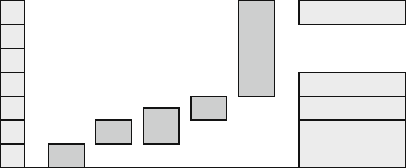
484 13 Switches and Routers
5. Packet routing is simple since there is only one route associated with all the
packets belonging to a call.
6. In-sequence delivery of data is possible since the packets from a certain call
traverse the same route.
7. The channel is well utilized since different calls share the same channel. This
results in an overall gain in the network capacity, which is usually referred to as
statistical gain.
8. Packet loss can be detected by the network since the packets follow each other
in sequence and each carries a unique sequence number.
9. Virtual circuit switching is suited to both bursty and constant bit rate traffic.
To establish a path in virtual circuit switching, the same steps are followed as
in circuit switching: connection establishment, data transfer, then connection tear
down.
13.5 Packet Switching Hardware
We review some of the hardware components that are commonly used in communi-
cation networks. We should point out that the following definitions are not very strict
since the capabilities of the components become more sophisticated with advances
in technology. The component capabilities are implemented in software or hardware
and there are grey areas where a device bridges the gap between two classifications
or partially implements the functionality of a given class of devices. We discuss
below several important networking components in the order of their level of com-
plexity. Figure 13.5 shows the ISO and TCP/IP reference model layers implemented
by the different components: hubs, bridges, switches, routers, and gateways.
13.5.1 End-Node
An end-node is a device that is attached to the network. The user accesses the net-
work through the end-node, which could be a workstation, a PC, a printer, a file
server, etc.
Fig. 13.5 Hubs, bridges,
switches, routers, and
gateways and the layers
implemented by each
component
ISO Model
7
6
5
4
3
2
1
Hub
Bridge
Switch
Router
Gateway
TCP/IP Model
Application
Transport
Internet
Host-to-network
13.5 Packet Switching Hardware 485
13.5.2 Hub
A hub connects several segments of a LAN. A hub has several ports such that when
a packet arrives at a port, it is copied to all the other ports so that all segments of the
LAN see the packet. In that sense, a hub acts as a repeater to repeat one message on
one LAN to all the other LANs [3].
A passive hub serves simply as a conduit for the data, enabling it to go from
one device (or network segment) to another. An intelligent hub includes additional
features that enable an administrator to monitor the traffic passing through the hub
and to configure each port in the hub. A switching hub actually reads the destination
address of each packet and then forwards the packet to the correct port based on
the header information. A hub does not improve network capacity or performance.
It only acts as the “wiring” between the network segments. Thus we can think of
the hub as operating mainly in Layer 1 of the ISO reference model since it only
enables the operation of the physical layer of the ISO reference model. Figure 13.5
shows the location of the hub and the other main network connectivity components
in relation to the ISO reference model layers.
13.5.3 Bridge
A bridge is a device that connects two local-area networks (LANs) or two segments
of the same LAN. The two LANs being connected can be alike or dissimilar. For ex-
ample, a bridge can connect an Ethernet with a token-ring network. Unlike routers,
bridges are protocol independent. They simply forward packets without analyzing
and re-routing messages. Consequently, they are faster than routers, but less versa-
tile. A bridge uses the packet header to determine whether to pass the packet to the
other LAN or not. A bridge operates at Layer 2 of the ISO reference model since it
supports the operation of the data link (network access ) layer . A bridge is simpler
than a router but still requires a switch for delivering the packets to the correct output
port.
13.5.4 Switch
A switch connects several LANs. A switch has several ports such that when a
packet arrives at a port, it is forwarded only to the appropriate output port based
on the header information. In that sense, a switch provides a temporary dedicated
connection between an input port and an output port. A switch improves network
performance by dividing the network into several independent segments, thereby
increasing the overall capacity. In that sense, the switch is smarter than a hub. Typ-
ically, switches work in Layer 2 of the ISO reference model, which is equivalent
to a bridge. The new trend is to move to Layer 3 switching, which is capable of
switching millions of packets per second. It should be mentioned that a switch is

486 13 Switches and Routers
protocol specific. However, newer switches are able to handle several protocols such
as multi-protocol label switching (MPLS).
13.5.5 Router
A router connects networks that may or may not be similar. A router uses the packet
header and a forwarding table to determine the best way a packet should go between
the networks. Routers use ICMP
2
to communicate with each other and determine the
best route between any two hosts. Very little filtering of data is done through routers.
Routers know how the whole network is connected and how to move information
from one part of the network to another. They free the end-nodes from having to do
these tasks. Routers enhance the network by connecting networks that use different
protocols. Note that a router requires the use of a switch to perform its packet rout-
ing (switching) functions. Routers are smarter than hubs and switches. The router
operates at Layer 3 of the ISO reference model since its supports the operation of
the network layer (such as data transmission and switching) [2] .
13.5.6 Gateway
A gateway is a computer that uses a combination of hardware and software to link
two different types of networks using different protocols. Gateways between e-mail
systems, for example, allow users on different e-mail systems to exchange messages.
Thus a gateway translates between two different protocols and sometimes topolo-
gies. For example, a gateway is needed to translate between TCP/IP over Ethernet
and ATM over SONET. We can think of the gateway as operating mainly above
Layer 3 of the ISO model since its enables the operation of the application layer and
above.
From the above definitions, we see that a switch is the basic component of net-
working, and the design of an efficient high-speed switch is absolutely necessary to
obtain networks capable of meeting customer demands for ever-increasing capacity
and reduced delay.
13.6 Basic Switch Components
As was explained above, network routers rely on switches to perform their functions.
Thus it is worthwhile to study the construction of switches in more detail. A switch
is a hardware device that accepts packets at its inputs and routes them to its outputs
according to the routing information provided in the packet header and the switch
2
Internet Control Message Protocol. ICMP supports packets containing error, control, and infor-
mational messages.
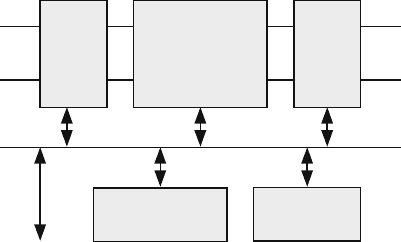
13.6 Basic Switch Components 487
Fig. 13.6 Basic components
of a switch
Input
Switch Fabric
(SF)
Output
Control
Input
Ports
Outpu
t
Ports
Interface to
Control Processor
...
...
Network Processor
Unit (NPU)
routing table. Figure 13.6 is a block diagram showing the main components of a
switch.
The switch has three main architectural components: a network processor unit
(NPU), a controller, a datapath comprising input/output ports, and switch fabric.
The functionalities of each are explained in the following sections. In general, the
functions of intensive data processing and control should be distributed, whenever
possible, among the different switch components to reduce the delay and be able
to handle many inputs/outputs simultaneously. The components of the switch that
have the most impact on its performance are the storage buffers/queues and the
switch fabric. For example, packet loss in the switch results due to buffer overflow
or inability to establish a path from an input to an output port through the switching
fabric. Also, the maximum line rate depends on the memory access speed.
13.6.1 Network Processing Unit (NPU)
The network processing unit is required to do compute-intensive tasks to enable
the switch to process data at high speeds. An NPU is a programmable processor
with special instructions or hardware components that are specifically designed to
efficiently perform networking tasks. A general-purpose processor proves too slow
to do the required networking tasks. However, specialized hardware meets the de-
mands but has the disadvantages that once the tasks or protocols are upgraded, a
major redesign is required and this takes time. By the time a specialized hardware is
available, the protocols might have changed already. Thus the major motives for an
NPU are flexibility/programmability and efficiency in executing networking tasks.
Figure 13.7 shows a switch with NPU-specialized hardware components that do
specific tasks. Examples of the tasks that the NPU might be required to perform
include the following:
1. Implementation of security protocols for firewalls, network security, data encryp-
tion/decryption, etc
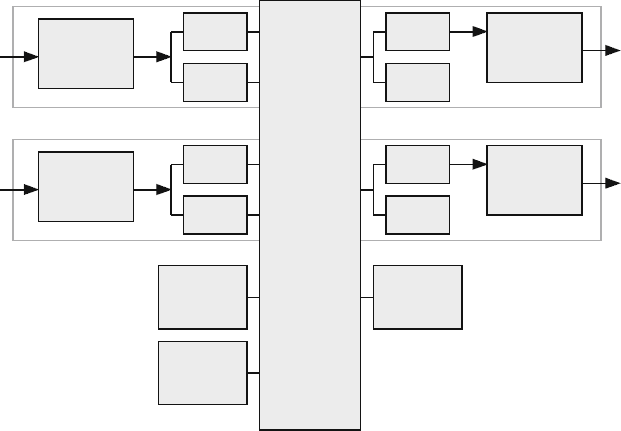
488 13 Switches and Routers
Classify &
Forward
Classify &
Forward
N input
buffers
N input
buffers
Line Card # 1
...
...
...
...
...
Deep packet
parsing
processor
Security
processor
Network
processor
controller
...
PHY
* POS
* ATM
* ETHERNET
PHY
* POS
* ATM
* ETHERNET
PHY
* POS
* ATM
* ETHERNET
PHY
* POS
* ATM
* ETHERNET
Line Card # N
Schdeuler
Virtual
Queues
Schdeuler
Virtual
Queues
Switch fabric/
Bus Matrix
Fig. 13.7 A switch incorporating NPU components
2. Deep packet search which is essentially string search for pattern matching using
the packet payload as input
3. Implementation of quality of service protocols
4. Traffic shaping
5. Packet routing using routing tables
6. Interface
13.6.2 Control Section
The control section deals with packet streams and establishing and tearing down
circuits and is composed of the bottom two components of the switch block diagram
in Fig. 13.6. The control section performs the following functions:
1. Maintains the contents of the routing table, which determines the proper destina-
tion output port of an incoming packet
2. For the case of circuit switching, decides whether to accept new connections or
not based on current utilization of switch resources
3. Provides congestion control for the switch by continually monitoring the switch
resources (e.g., buffer occupancy) and issuing proper actions
4. Assigns switch resources to the established connections based on the class of
service
13.6 Basic Switch Components 489
It should be mentioned that these functionalities could be centralized or they
could be distributed between the input and output ports. The latter option is desirable
to ensure high-speed operation.
13.6.3 Datapath Section
The datapath deals with individual packets or cells and is composed of the top three
components of the switch block diagram in Fig. 13.6. The datapath performs the
following functions:
1. Accepts incoming packets on any of its N input ports and stores them in tempo-
rary buffers for processing their header information
2. Establishes a path to the desired output port through the switch fabric (SF)
3. Stores the routed packets in the output queues and schedules the stored packets
for transmission based on some scheduling protocol
13.6.4 Switch Fabric
The switch fabric (SF) establishes the required paths between pairs of input and out-
put ports. The switch fabric must also support any type of connection such as single
cast (one input to one output), multicast (one input to many outputs), broadcast (one
input to all outputs), or hot point (many inputs to one output). A detailed discussion
of switch fabrics and their performance is found in Chapter 14.
13.6.5 Lookup Table Design
The routing or lookup table stores information about which output ports should
receive a packet that arrives at an input port. This information is maintained and
updated by the control processor. The data in the lookup table could be organized
using any of the following approaches:
1. Heap storage: Store the data in a heap with no particular order using a random-
access memory (DRAM or SRAM). This approach is simple but searching for
a particular data item requires searching the entire memory. RAMs suffer from
I/O port limitations (typically one!) and large cycle time. Thus accessing the
database is done one item at a time using a slow search strategy which is not
practical in high-speed switches.
2. Content-addressable memory (CAM): This is sometimes called associative mem-
ory or associative storage. CAM could be a small memory but complex in design
and slow in performance. Searching for a data item is done in a distributed fash-
ion within the memory which speeds up the search operation. The design of an
490 13 Switches and Routers
efficient and fast CAM is certainly a challenging and exciting hardware design
problem.
3. Hash tables: Here the input header information is compressed to a smaller num-
ber of bits (e.g., from 48 bits to 16 bits) using a hashing function to reduce the
RAM size [4–6]. The hashing function should be simple to implement without
requiring much processing time. Typically, hashing functions are implemented
using a linear feedback shift register (LFSR) that performs polynomial division.
The input to the LFSR is treated as a polynomial and the LFSR contents are the
“signature” that corresponds to the input. See Appendix F for a discussion of
hashing.
4. Balanced tree (B-tree): The B-tree is a data structure that is used to efficiently
build large dictionaries and implement the algorithms used to search, insert, and
delete keys from it. The advantage of using B-trees for constructing lookup tables
is the small time required to search for the routing information. However, com-
plex hardware design is required to implement the other lookup table functions
such as data insertion and deletion. Again, the design of B-trees is a very chal-
lenging and exciting hardware design project. See Appendix F for a discussion
of B-trees.
In an ATM switch, the routing table uses direct lookup to determine the desti-
nation output port and to update the VPI/VCI bytes. For an Ethernet switch, the
lookup table uses associative lookup (content-addressable memory or CAM). For
an IP router, the routing table could be based on the new CIDR or cache memory.
13.7 Switch Functions
A switch or a router has to perform several functions beside simply routing packets
from its inputs to its outputs.
13.7.1 Routing
The switch or router must be able to read the header of each incoming packet to
determine which output link must be used to move the packet to its destination. It is
obvious that an arriving packet cannot be routed until packet classification based on
its header information has been performed. These routing decisions are done using
routing tables. Techniques for building routing tables are discussed in more detail
in Section 13.6.5 and in Appendix F.
13.7.2 Traffic Management
When too many packets are present in the network, congestion is said to have taken
place. When congestion occurs in a router, the buffers become filled and packets
